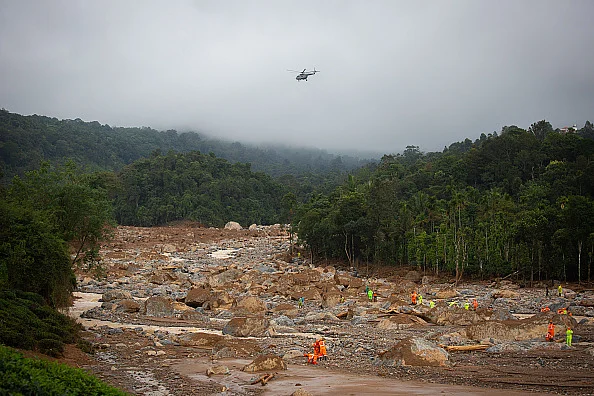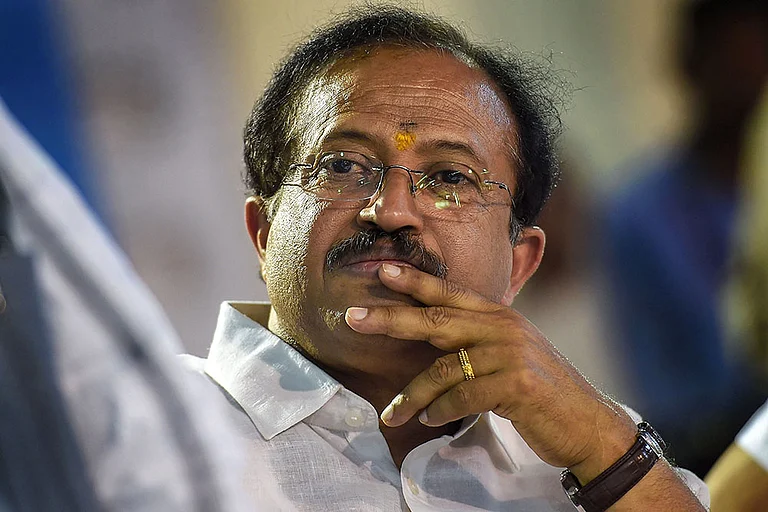A few days after the devastating landslide in Wayanad that claimed nearly 300 lives, a video of the Prime Minister's visit to the place went viral. The footage captured a moment between the Prime Minister and a young survivor, aged three or four, at a local hospital.
In the video, the child is seen affectionately playing with the Prime Minister's white beard as he holds her. The Prime Minister fondly allows this, smiling as the little girl reaches for his glasses. Her mother gently pulls her back, but the Prime Minister continues to caress the child warmly.
However, criticism too came in. The critics demanded the Union Government to release disaster relief to the State. Such display of affection makes no sense unless Kerala gets its due share of disaster aid, say the critics. Outlook is looking at the present status of the disbursal of relief fund to Kerala by the Union Government in the recurring natural calamities since a few years.

The Landslide in Wayanad on July 30, 2024.
The landslide that took the lives of around 300 individuals is one of the worst in the country recorded in the recent past. 1,555 houses were completely washed away in the landslide, which also left 2,007 houses uninhabitable. 4,000 people were displaced from their homes and were shifted to relief camps. According to the Kerala State Disaster Management Authority, the actual estimate of loss worth Rs 1,202.12 Cr.
The State Government has submitted a memorandum to the Union Government furnishing the total and accumulated loss along with an estimate for rebuilding the villages. According to the memorandum, Wayanad would require Rs 2,262 Cr for rebuilding and rehabilitation, catering to the living standards of the survivors. However, the State has received zero aid till date.
Though the memorandum was submitted on August 17, 2024, the State has received no specific disaster relief so far. As entrusted by the Government, Dr K V Thomas, former Union Minister who is currently serving as the representative of Kerala in Delhi, met the Finance Minister and urged immediate financial assistance to the State.
The Kerala High Court, in a suo moto writ petition asked the Union Government to furnish the details of the relief assistance given to the State. The High Court has also instructed the Union Government to provide immediate additional aid to the State from the Prime Minister’s Distress Relief Fund. The Kerala High Court has asked the National Disaster Management Authority to inform whether they would be willing to write off the loans taken by the affected families, including vehicle loans and housing loans. The Union Government has sought time to furnish the details.
‘Disaster relief to Kerala disproportionately low’
Not just Wayanad landslide, but all the recent natural calamities that hit Kerala tell the same story. The disaster relief received from the Union Government has been disproportionately law comparing with what other States received. The amount released by the Centre is nowhere near to the claim/demand raised by the State over ten years according to the data.
A cursory look through the central share of State Disaster Relief Fund (SDRF) to various States strengthens Kerala’s argument that the State has been discriminated in granting disaster aid. According to the Ministry of Home Affairs, the Union Government has dispersed ₹ 5,858.60 crore to 14 flood-affected states as a central share from the State Disaster Response Fund (SDRF) and an advance from the National Disaster Response Fund (NDRF) during 2024/25 .

According to a press release issued by MHA on October 1, 2024, this include Rs1,492 crore to Maharashtra, Rs 1,036 crore to Andhra Pradesh, Rs 716 crore to Assam, Rs 655.60 crore to Bihar, Rs 600 crore to Gujarat, Rs 189.20 crore to Himachal Pradesh, Rs 416.80 crore to Telangana and Rs 468 crore to West Bengal. The amount released to Kerala is the lowest(among big States) which is Rs 145 Cr. According to experts, the Wayanad Landslide is the worst natural calamity in terms of impact in the recent history of the country. “Many other States that received bigger amount, did not experience a calamity as worst as Kerala did this year, but we got the last priority in terms of relief” K Rajan, Revenue Minister of Kerala said to Outlook.
A study by a group of experts published in the open research platform Authoria indicates that Wayanad landslide is one of the worst in the history of natural disasters in India. According to this research paper, the volume of the eroded materials from the event makes it one of India's largest debris flows. ‘The July 2024 Wayanad debris flow, with an estimated volume of 5.1 to 5.7 million cubic meters (MCM), ranks among the largest debris flow events in recent Indian history. This event caused extensive damage and loss of life in the Chaliyar River Valley, triggered by intense rainfall and the region’s geologically unstable terrain. It is notable not only for its size but also for its devastating impact on both human settlements and the environment’, states the study.
The severity of the disaster remains unquestioned. Even the Prime Minister agreed this during his visit to Kerala. “In the meeting with the honourable Prime Minister, he told us that the severity of the landslide reminds him of the 1979 calamity that happened in his own State” Revenue Minister K Rajan stated in the Kerala Assembly during the debate on the impact and rehabilitation of the landslide.
The data provided by the Kerala Disaster Management Authority throws light on the disproportionality in demand and supply of disaster aid. Kerala raised a demand of Rs 4,796.4 Crore as relief for the 2018 floods and the State was granted 2,904.85 Cr only. Similarly in the Okhi cyclone in 2017, the State asked for a relief of Rs 431 Cr and the amount granted by the Union Government was only 111.7 Cr. The State raised a demand of Rs 2,101.88 Cr as relief for the 2019 floods. According to the Kerala Disaster Management Authority, the State received no money in terms of relief from the Union Government for the 2019 floods.
Multiple sources confirm that the unprecedented rainfall lead to the landslide in Wayanad. The FIR prepared by the Geological Survey of India notes that ‘the excessive rainfall is the major triggering factor which results in increase of pore water pressure and reduction of strength on super saturation initiated the landslide’.
Nearly 15% of the land area of the State is prone to landslides. Fatal incidents of landslides are on the rise in the State. The State was hit by a series of landslides in 2019 that took 125 lives. In August 2020, a major landslide wreaked havoc in Pettimudi in Idukki District in which 66 people died. The landslide occurred in October 2021 in Kottayam District took the lives of 13 individuals. Countless number of landslides happen deep inside the forest every year which does not cause human causality and thus makes no news.




























